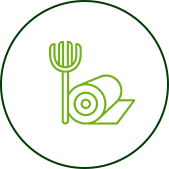Fresh turf direct from the farm 1800 458 859

Fresh turf direct from the farm 1800 458 859

Turf grass diseases are difficult to understand because the biological organisms causing the problems are rarely observed. Fortunately, grasses maintained using proper cultural practices (water, mowing, and fertiliser) are not as likely to become diseased or be as severely damaged as grasses not receiving proper care. All types of turf can be affected by diseases, read below to learn more.
Anthracnose is especially common during warm, humid weather. Identified through irregularly shaped patches that have infected areas, it is a reddish-brown colour that turns yellow and tan. The younger leaves are generally red. Treat with an approved fungicide.
Brown patch is a disease of summer and early autumn when the weather is cool and wet. The characteristic of brown patch is the “smoke ring” with the disease. This ring of dark grey (fungus mycelium) is not always present, but when it is, it sits around the infected area and will disappear as the foliage dries. The affected areas can grow up to a total of one metre in diameter. Brown patch occurs in all mainland states and is widespread in NSW. Treat with an approved fungicide to get rid of.
The name of this disease comes from its appearance. When appearing, the dead straw-coloured spots are about the size of a dollar. Commonly found in seasons with low rainfall due to the effect of low soil moisture in the grass, Dollar Spot is active between early summer and early autumn. To get rid of, it is recommended you treat with an approved fungicide.
A circle or arc of stimulated grass or toadstools, fairy rings appear during the spring or summer. Varying from a few centimetres to 20 metres in diameter, the lush growth rings in the lawn are caused by the release of nutrients, nitrogen in particular, from the activity of the fungus living on organic matter in the soil. The hydrophobic nature of the soil profile needs to be reversed using wetting agents and then the use of an appropriate fungicide.
A common disease found in the colder season, Winter Fusarium usually impacts finer grass such as those used on bowling and golf greens. They appear as small circular water-soaked spots less than 5cm in diameter. Soils that are high in nitrogen and low in phosphorous and potassium favour this disease. Balance fertility and soil pH, increase air circulation.
This disease can occur at any time of the year. It generally happens when there is a lot of moisture around and not much wind to dry the grasses. Helminthosporium Leaf Spot/Black causes small lesions on the leaf blades.
This disease is prevalent in hot, humid weather and where there is poor drainage and air circulation. The patches of infection enlarge at a rapid rate.
Dead leaves interspersed with uninfected leaves is one of the first symptoms. Occurring in spring and autumn during humid periods, this disease is severe on slow-growing lawns that are nitrogen-deficient. A noticeable symptom is the water-soaked patches of grass that appear in the spring. The infected grass blades soon die and fade to a bleach tan colour when dry.
Rolf’s Disease occurs in the warm conditions of spring and summer. Circular areas of 15-45cm in diameter appear with rings of dead grass.
Spring Dead Spot favours cool, wet weather and daily temperatures of less than 15C. True to its name, it generally comes out in spring when grass resumes growth and appears in circular areas of dead grass that are 15-30cm in diameter. It has a more severe impact on mature turf and in areas with long winters and cold temperatures.
Mainly active in cool, wet yards, Take All Patch is often seen on lawns with poorly drained soil. First appearing with yellowing leaves and a darkening of the roots, small, light brown dead patches will appear and then continually spread. When winter hits, the affected areas turn grey.
* Turfgrass Disease Management M.L.Elliot and G.W.Simone
Want to succeed with your new lawn? Read more about preparing your site, laying your turf, watering, fertilising, turf maintenance, lawn insects and weeds, or visit our lawn care store.
Below is a general turf maintenance chart that will ensure your lawn looks good all-year-round. Please consult with your turf supplier to check that this is the right routine for your turf variety as some may vary depending on the location and weather conditions.
| Jan | Feb | Mar | Apr | May | Jun | Jul | Aug | Sep | Oct | Nov | Dec | |
|---|---|---|---|---|---|---|---|---|---|---|---|---|
| Fertilising For a healthy green lawn, fertilise every 6-8 weeks |  |  |  |  |  |  |  |  |  | |||
| Spraying Spray your lawn with grub killer and fungicide in the warmer, humid months |  |  |  |  |  |  | ||||||
| Weed Spraying During the cooler time of year to prevent excessive damage to turf |  |  |  |  |  | |||||||
| Top Dressing During spring time when your lawn is growing more rapidly |  |  |  |
Explore our range and find the right grass for your lawn.
Get value for your money by ordering quality turf from the professionals who care.

We take pride in providing helpful and responsive customer service. Our friendly staff can answer your questions and help you select the right turf for you.

Our turf is all freshly harvested to order and promptly delivered to ensure ultimate freshness, always ensuring our customers only receive turf of the highest quality.

As licensed turf farmers, we provide the highest quality turf – giving the best lawn for your property. With our AusGap certification, you can trust we only ever grow and offer the best.

There is no need to stress when purchasing our turf. Lawn Solutions Australia backs our turf and has a ten-year product warranty for your peace of mind.